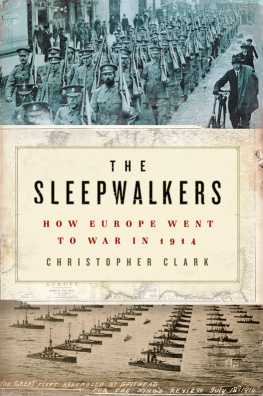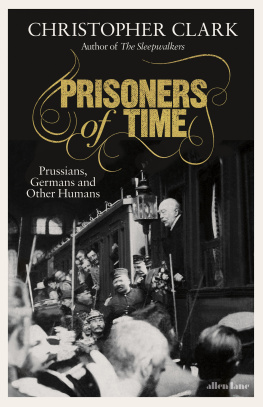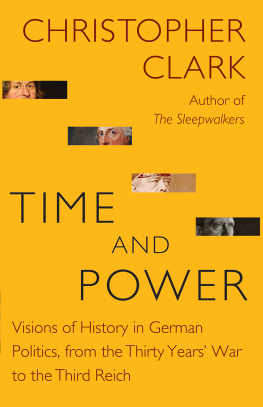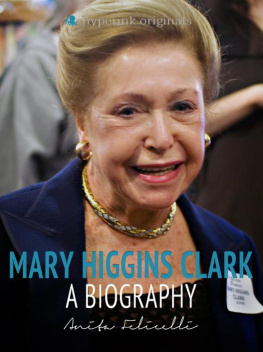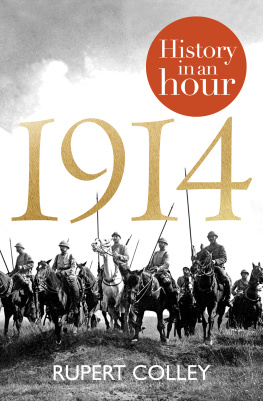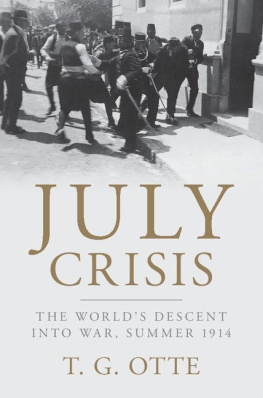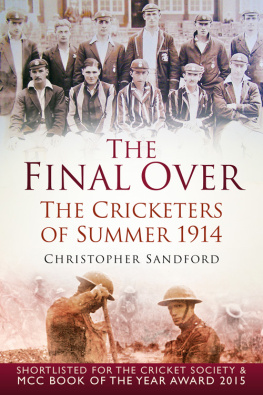
For Josef and Alexander
Contents
PART I
Roads to Sarajevo
PART II
One Continent Divided
PART III
Crisis
On 12 May 1916, James Joseph OBrien, grazier, of Tallwood Station in northern New South Wales applied to enlist in the Australian Imperial Force. After training for two months at the Sydney showgrounds, Private OBrien was assigned to the 35th Battalion of the 3rd Division of the AIF and embarked on the SS Benalla for England, where he received further training. On around 18 August 1917, he joined his unit in France, in time to take part in the battles of the Third Ypres campaign.
Jim was my great-uncle. He had been dead for twenty years when my aunt Joan Pratt, ne Munro, gave me his wartime journal, a small brown notebook full of packing lists, addresses, instructions and the odd laconic diary entry. Commenting on the battle for Broodseinde Ridge on 4 October 1917, Jim wrote: It was a great battle and I have no desire to see another. This is his account, dated 12 October 1917, of the battle of Passchendaele II:
We left the details camp (which was close to Ypres) and made for the Passchendaele sector of the line. It took us ten hours to get there and we were tired out after the march. Twenty-five minutes after arriving there (which was 5.25 on the morning of the 12th) we hopped over the bags. All went well until we reached a marsh which gave us great trouble to get through. When we did get through, our barrage had shifted ahead about a mile and we had to make pace to catch it. About 11 a.m. we got to our second objective and remained there until 4 p.m., when we had to retreat, [...] It was only the will of God that got me through, for machine gun bullets and shrapnel were flying everywhere.
Jims active war service came to an end at 2 a.m. on 30 May 1918, when, in the words of his journal, he stopped a bomb from the Fatherland and got wounded in both legs. The shell had fallen at his feet, blowing him upwards and killing the men around him.
By the time I knew him, Jim was a wry, frail old man whose memory was on the blink. He was reticent on the subject of his war experience, but I do remember one conversation that took place when I was around nine years old. I asked him whether the men who fought in the war were scared or keen to get into the fight. He replied that some were scared and some were keen. Did the keen ones fight better than the scared ones, I asked. No, said Jim. It was the keen ones who shat themselves first. I was deeply impressed by this reply and puzzled over it especially the word first for some time.
The horror of this remote conflict still commands our attention. But its mystery lies elsewhere, in the obscure and convoluted events that made such carnage possible. In exploring these, I have accumulated more intellectual debts than I can possibly repay. Conversations with Daniel Anders, Margaret Lavinia Anderson, Chris Bayly, Tim Blanning, Konstantin Bosch, Richard Bosworth, Annabel Brett, Mark Cornwall, Richard Drayton, Richard Evans, Robert Evans, Niall Ferguson, Isabel V. Hull, Alan Kramer, Gnther Kronenbitter, Michael Ledger-Lomas, Dominic Lieven, James Mackenzie, Alois Maderspacher, Mark Migotti, Annika Mombauer, Frank Lorenz Mller, William Mulligan, Paul Munro, Paul Robinson, Ulinka Rublack, James Sheehan, Brendan Simms, Robert Tombs and Adam Tooze have helped me to sharpen arguments. Ira Katznelson provided advice on decision theory; Andrew Preston on adversarial structures in the making of foreign policy; Holger Afflerbach on the Riezler diaries, the Triple Alliance and finer details of German policy in the July Crisis; Keith Jeffery on Henry Wilson; John Rhl on Kaiser Wilhelm II. Hartmut Pogge von Strandmann drew my attention to the little-known but informative memoirs of his relative Basil Strandmann, who was the Russian charg daffaires in Belgrade when war broke out in 1914. Keith Neilson shared an unpublished study of the decision-makers at the apex of the British Foreign Office; Bruce Menning allowed me to see his important article, forthcoming in Journal of Modern History, on Russian military intelligence; Thomas Otte sent me a pre-publication pdf of his magisterial new study The Foreign Office Mind and Jrgen Angelow did the same with his Der Weg in die Urkatastrophe; John Keiger and Gerd Krumeich sent offprints and references on French foreign policy; Andreas Rose sent a copy fresh from the press of his Zwischen Empire und Kontinent; Zara Steiner, whose books are landmarks in this field, was generous with her time and conversation and shared a dossier of articles and notes. Over the last five years, Samuel R. Williamson, whose classic studies of the international crisis and Austro-Hungarian foreign policy opened several of the lines of enquiry explored in this book, sent unpublished chapters, contacts and references and allowed me to pick his brains on the arcana of Austro-Hungarian policy. The email friendship that resulted has been one of the rewards of working on this book.
Thanks are also due to those who helped me surmount linguistic boundaries: to Miroslav Doen for his help with Serbian printed sources and to Srdjan Jovanovi for assistance with archival documents in Belgrade; to Rumen Cholakov for help with Bulgarian secondary texts and to Sergei Podbolotov, unstinting labourer in the vineyard of history, whose wisdom, intelligence and wry humour made my research in Moscow as enjoyable and enlightening as it was productive. Then there are those generous spirits who read part or all or the work in various states of completion: Jonathan Steinberg and John Thompson both read every word and offered insightful comments and suggestions. David Reynolds helped to put fires out in the most challenging chapters. Patrick Higgins read and criticized the first chapter and warned of pitfalls. Amitav Ghosh provided invaluable feedback and advice. For all the errors that remain, I accept responsibility.
I am fortunate in having a wonderful agent in Andrew Wylie, to whom I owe a great deal, and immensely grateful to Simon Winder of Penguin and Tim Duggan of HarperCollins for their encouragement, guidance and enthusiasm, and to Richard Duguid for overseeing the books production with amiable efficiency. The indefatigable copy-editor Bela Cunha sought out and destroyed all the errors, infelicities, inconsistencies and aphids (superfluous quotation marks) she could find and remained cheerful just in the face of my efforts to drive her mad by tampering endlessly with the text. Nina Lbbren, whose grandfather Julius Lbbren was also at Passchendaele in 1917 (on the other side), tolerated my labours from a standpoint of benevolent neutrality. The book is dedicated with love and admiration to our two sons, Josef and Alexander, in the hope that they will never know war.

The European continent was at peace on the morning of Sunday 28 June 1914, when Archduke Franz Ferdinand and his wife Sophie Chotek arrived at Sarajevo railway station. Thirty-seven days later, it was at war. The conflict that began that summer mobilized 65 million troops, claimed three empires, 20 million military and civilian deaths, and 21 million wounded. The horrors of Europes twentieth century were born of this catastrophe; it was, as the American historian Fritz Stern put it, the first calamity of the twentieth century, the calamity from which all other calamities sprang. The debate over why it happened began before the first shots were fired and has been running ever since. It has spawned an historical literature of unparalleled size, sophistication and moral intensity. For international relations theorists the events of 1914 remain the political crisis
Next page
